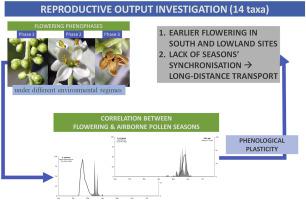当前位置:
X-MOL 学术
›
Atmos. Environ.
›
论文详情
Our official English website, www.x-mol.net, welcomes your feedback! (Note: you will need to create a separate account there.)
Flowering of woody plants: The fingerprint of airborne pollen seasons? Evidence from phenological observations in 14 taxa in a mediterranean ecosystem
Atmospheric Environment ( IF 5 ) Pub Date : 2020-11-01 , DOI: 10.1016/j.atmosenv.2020.117708 Athanasios Damialis , Athanasios Charalampopoulos , Maria Lazarina , Eleni Diamanti , Vasiliki Almpanidou , Afroditi Maria Maraidoni , Aliki Symeonidou , Evgenia Staikidou , Eleana Syropoulou , Kleopatra Leontidou , Ioannis Tsiripidis , John M. Halley , Despoina Vokou
Atmospheric Environment ( IF 5 ) Pub Date : 2020-11-01 , DOI: 10.1016/j.atmosenv.2020.117708 Athanasios Damialis , Athanasios Charalampopoulos , Maria Lazarina , Eleni Diamanti , Vasiliki Almpanidou , Afroditi Maria Maraidoni , Aliki Symeonidou , Evgenia Staikidou , Eleana Syropoulou , Kleopatra Leontidou , Ioannis Tsiripidis , John M. Halley , Despoina Vokou

|
Abstract Flowering and pollen seasons are sensitive to environmental variability and are considered climate change indicators. However, it has not been concluded to what extent flowering phenology is indeed reflected in airborne pollen season locally. The aim of this study was to investigate, for a wide spectrum of plant species, the responsiveness of flowering to different environmental regimes and also to check for commensurate changes in the respective pollen seasons. Fourteen taxa were selected representing the families of Corylaceae, Cupressaceae, Fagaceae, Oleaceae, Pinaceae and Platanaceae. Each was studied for at least one full flowering year and in at least two sampling stations differing in elevation or direction within the period 2004–2011. Flowering observations were made 2–3 times a week, from flower differentiation to flower desiccation; >1000 daily observations were made in 225 plant individuals, in total. Data were regressed against meteorological parameters in an attempt to identify the driving factors of flowering onset and offset. Flowering dates were compared with dates of the related airborne pollen seasons per taxon; airborne pollen monitoring took place daily using a Hirst-type volumetric sampler. For all taxa, flowering started earlier at lower elevations or southern direction. Cumulative temperature proved to be the factor most significantly affecting flowering onset and end for all species (p 0.70). For the majority of the taxa examined, airborne pollen season did not coincide locally with the respective flowering periods of the selected species: flowering could precede pollen season, even for more than one month (as in C. avellana), or start after the pollen season onset (as in P. brutia). The strong sensitivity of flowering to air temperature is not the case in the respective pollen seasons. This raises questions on the relationship between flowering times and airborne pollen seasons and on the rather underestimated role of long-distance transport of pollen.
中文翻译:

木本植物的开花:空气中花粉季节的指纹?地中海生态系统中 14 个分类群的物候观测证据
摘要 开花和花粉季节对环境变化很敏感,被认为是气候变化的指标。然而,尚未得出结论开花物候在何种程度上确实反映在当地的空气传播花粉季节。本研究的目的是调查广泛的植物物种开花对不同环境状况的反应,并检查相应花粉季节的相应变化。选择了代表 Corylaceae、Cupressaceae、Fagaceae、Oleaceae、Pinaceae 和 Platanaceae 科的 14 个分类群。在 2004 年至 2011 年期间,每一个都至少在一个完整的开花年份和至少两个海拔或方向不同的采样站进行了研究。开花观察每周进行 2-3 次,从花分化到花干燥;总共对 225 个植物个体进行了 >1000 次每日观察。数据根据气象参数进行回归,试图确定开花开始和偏移的驱动因素。将开花日期与每个分类群相关的空气传播花粉季节的日期进行比较;每天使用 Hirst 型体积采样器进行空气中花粉监测。对于所有分类群,在较低海拔或向南方向开花较早。累积温度被证明是最显着影响所有物种开花开始和结束的因素(p = 0.70)。对于大多数检查的分类群,空气传播的花粉季节与所选物种的各自开花期在局部不重合:开花可能先于花粉季节,甚至超过一个月(如 C. avellana),或在花粉季节开始后开始(如 P. brutia)。开花对气温的强烈敏感性在各自的花粉季节并非如此。这对开花时间与空气传播花粉季节之间的关系以及花粉长途运输的作用被低估的作用提出了质疑。
更新日期:2020-11-01
中文翻译:

木本植物的开花:空气中花粉季节的指纹?地中海生态系统中 14 个分类群的物候观测证据
摘要 开花和花粉季节对环境变化很敏感,被认为是气候变化的指标。然而,尚未得出结论开花物候在何种程度上确实反映在当地的空气传播花粉季节。本研究的目的是调查广泛的植物物种开花对不同环境状况的反应,并检查相应花粉季节的相应变化。选择了代表 Corylaceae、Cupressaceae、Fagaceae、Oleaceae、Pinaceae 和 Platanaceae 科的 14 个分类群。在 2004 年至 2011 年期间,每一个都至少在一个完整的开花年份和至少两个海拔或方向不同的采样站进行了研究。开花观察每周进行 2-3 次,从花分化到花干燥;总共对 225 个植物个体进行了 >1000 次每日观察。数据根据气象参数进行回归,试图确定开花开始和偏移的驱动因素。将开花日期与每个分类群相关的空气传播花粉季节的日期进行比较;每天使用 Hirst 型体积采样器进行空气中花粉监测。对于所有分类群,在较低海拔或向南方向开花较早。累积温度被证明是最显着影响所有物种开花开始和结束的因素(p = 0.70)。对于大多数检查的分类群,空气传播的花粉季节与所选物种的各自开花期在局部不重合:开花可能先于花粉季节,甚至超过一个月(如 C. avellana),或在花粉季节开始后开始(如 P. brutia)。开花对气温的强烈敏感性在各自的花粉季节并非如此。这对开花时间与空气传播花粉季节之间的关系以及花粉长途运输的作用被低估的作用提出了质疑。



























 京公网安备 11010802027423号
京公网安备 11010802027423号